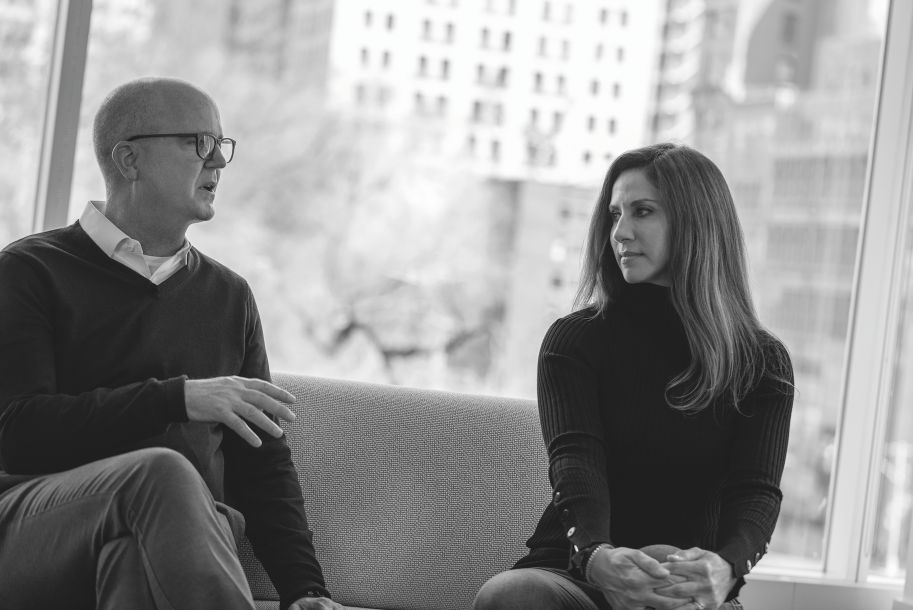
How do our decisions make an impact at every scale? – a Q&A with Shaw Contract
How do our decisions make an impact at every scale? – a Q&A with Shaw Contract
Share
Shaw Contract vice president of marketing John Stephens and Shaw Industries global sourcing director of raw materials Shannan Billings exchange thoughts on designing with the planet at the forefront in this excerpt from Shaw Contract’s sustainability Journal Two Degrees.
You could call this a marriage of the minds. He’s a former history major. She can’t get through a meeting without using the word ‘molecule’ more than a dozen times. They share a belief system, an employer and their home. Is this a house united?

Sustainability is really top of mind for both of you – and a major focus for your company. Let’s jump right in. What concerns you?
JS: Yeah, so the clock’s ticking, right? I mean last year saw the most carbon dioxide emissions in history and there were 18 billion pounds of plastic put into the ocean. So there’s this sense of urgency I think we all should feel because there are negative impacts happening globally daily. That’s probably my biggest concern.
SB: My concern is our supply chain, all the way through to the petrochemical manufacturers. They know they need to pivot. They now see there’s a significant burden of sustainability or circularity – and that they need to make changes. They don’t have a really good answer at this point, but they are at the point of acknowledging that they have a challenge, and that they can support change, even within existing materials. They are starting to rethink their overall corporate edicts on profitability and doing the right thing. Over the next five, 10 to 20 years, that’s going to be an interesting story to watch. We’ve been doing this for more than a while at Shaw – achieving transparency of all ingredients in our materials. How can we partner with them to accomplish the goal?
What are some of the recent advances in material research that you’re really excited about?
SB: Bio-based materials are very exciting, utilising microorganisms to produce some of the petroleum-based chemicals in the marketplace. Those are some exciting advances as well as any sort of material reclamation, using larger volumes of reclaimed materials, much like we do with PET Resilient. How can we bring more recycled content to the products that we’re using?
JS: We launched a bio-based resilient product last year; our clients are asking for that. There are breakthrough new materials. But also, how do you take existing processes and redesign them in a way that is more sustainable, more responsible and improves product performance? As consumers, we want beautiful products, we want them to be sustainable and we want them to perform. Ideally, you don’t want to make trade-offs.

What are the questions you ask yourself when you’re embarking on a new project for Shaw Contract?
JS: For me it’s “why?” Why are we doing this? Who are we doing it for? What kind of impact will this initiative have? What resources do we need to be successful? And then, how do you define success?
SB: What kind of assumptions are we chasing with the project that we’re trying to put in place? I’m asking about the “how” of it and the resources that we’re going to need. What kind of leverage are we going to need outside of the resources we have internally? What kind of relationships are we going to have to develop in order to see that project or that product all the way through to completion? And, how can we quickly remove any sort of roadblocks to further progress?
How do designers and architects play into this discussion?
SB: Design reaches all the way through how a community gets built. When a supplier provides material that is healthy and safe, that helps create jobs and financial security for people and a way to improve their lives, expand their families and improve their communities.
JS: Several years ago there was an issue of Metropolis magazine with the cover line “Architects Pollute.” 50 percent of greenhouse gas emissions were attributed to decisions that architects and designers make. I think that was a wake up call for all of us. The more knowledge that we can share to make better decisions and understand the impact of those like climate change, like human health and safety, and the wellness of people who are in the buildings that we’re designing or we’re designing materials for. So yeah, there is a huge responsibility, but it’s empowering to make decisions that have longterm, global ramifications. decisions gives us both a responsibility and a sense of empowerment. What we do matters and what designers do matters. Our choices have long-range impacts on things.
Request a copy of Two Degrees and view the full article by contacting Shaw Contract: www.shawcontract.com/en-au 1800 556 302
Read more: Designer Adam Cornish on a return to accessible design and sustainability
You Might also Like





















